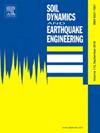Effects of partial excess pore water pressure generation and incomplete dissipation on the liquefaction resistance of fine sand
IF 4.2
2区 工程技术
Q1 ENGINEERING, GEOLOGICAL
引用次数: 0
Abstract
The influence of seismic history on the liquefaction resistance of saturated sand is a complex process that remains incompletely understood. Large earthquakes often consist of foreshocks, mainshocks, and aftershocks with varying magnitudes and irregular time intervals. In this context, sandy soils undergo two interdependent processes: (i) partial excess pore water pressure (EPWP) generation during foreshocks or moderate mainshocks, where seismic loadings elevate EPWP without causing full liquefaction and (ii) incomplete EPWP dissipation between seismic events due to restricted drainage. These processes leave behind persistent residual EPWP, reducing the liquefaction resistance during subsequent shaking. A series of cyclic triaxial tests simulating these mechanisms revealed that liquefaction resistance increases when the EPWP ratio ru < 0.6–0.8 (peaking at ru ~ 0.4) but decreases sharply at higher ru. Crucially, EPWP generation during seismic loading plays a dominant role in resistance evolution compared to reconsolidation effects. Threshold lines (TLs) mapping ru, the reconsolidation ratio (RR), and peak resistance interval (the range of ru where the peak liquefaction resistance is located) indicates that resistance decreases above TLs and increases below them, with higher cyclic stress ratios (CSR) weakening these effects. These findings provide a unified framework for assessing liquefaction risks under realistic multi-stage seismic scenarios.
部分超孔隙水压力产生和不完全耗散对细砂抗液化能力的影响
地震历史对饱和砂土抗液化能力的影响是一个尚未完全了解的复杂过程。大地震通常由不同震级和不规则时间间隔的前震、主震和余震组成。在这种情况下,砂质土壤经历了两个相互依存的过程:(i)在前震或中度主震期间产生的部分超孔隙水压力(EPWP),地震荷载使EPWP升高,但不会引起完全液化;(ii)由于排水受限,地震事件之间EPWP的不完全消散。这些过程会留下持久的残余EPWP,在随后的震动中降低液化阻力。模拟这些机理的三轴循环试验表明,EPWP比增大时,液化阻力增大;0.6-0.8(在0.4 ~ 0.4时达到峰值),但在更高的ru时急剧下降。关键是,与再固结效应相比,地震荷载过程中EPWP的产生在阻力演化中起主导作用。映射ru、再固结比(RR)和峰值阻力区间(ru峰值液化阻力所在范围)的阈值线(TLs)表明,在TLs以上,阻力减小,在TLs以下,阻力增大,较高的循环应力比(CSR)减弱了这些影响。这些发现为在真实的多阶段地震情景下评估液化风险提供了统一的框架。
本文章由计算机程序翻译,如有差异,请以英文原文为准。
求助全文
约1分钟内获得全文
求助全文
来源期刊

Soil Dynamics and Earthquake Engineering
工程技术-地球科学综合
CiteScore
7.50
自引率
15.00%
发文量
446
审稿时长
8 months
期刊介绍:
The journal aims to encourage and enhance the role of mechanics and other disciplines as they relate to earthquake engineering by providing opportunities for the publication of the work of applied mathematicians, engineers and other applied scientists involved in solving problems closely related to the field of earthquake engineering and geotechnical earthquake engineering.
Emphasis is placed on new concepts and techniques, but case histories will also be published if they enhance the presentation and understanding of new technical concepts.
 求助内容:
求助内容: 应助结果提醒方式:
应助结果提醒方式:


